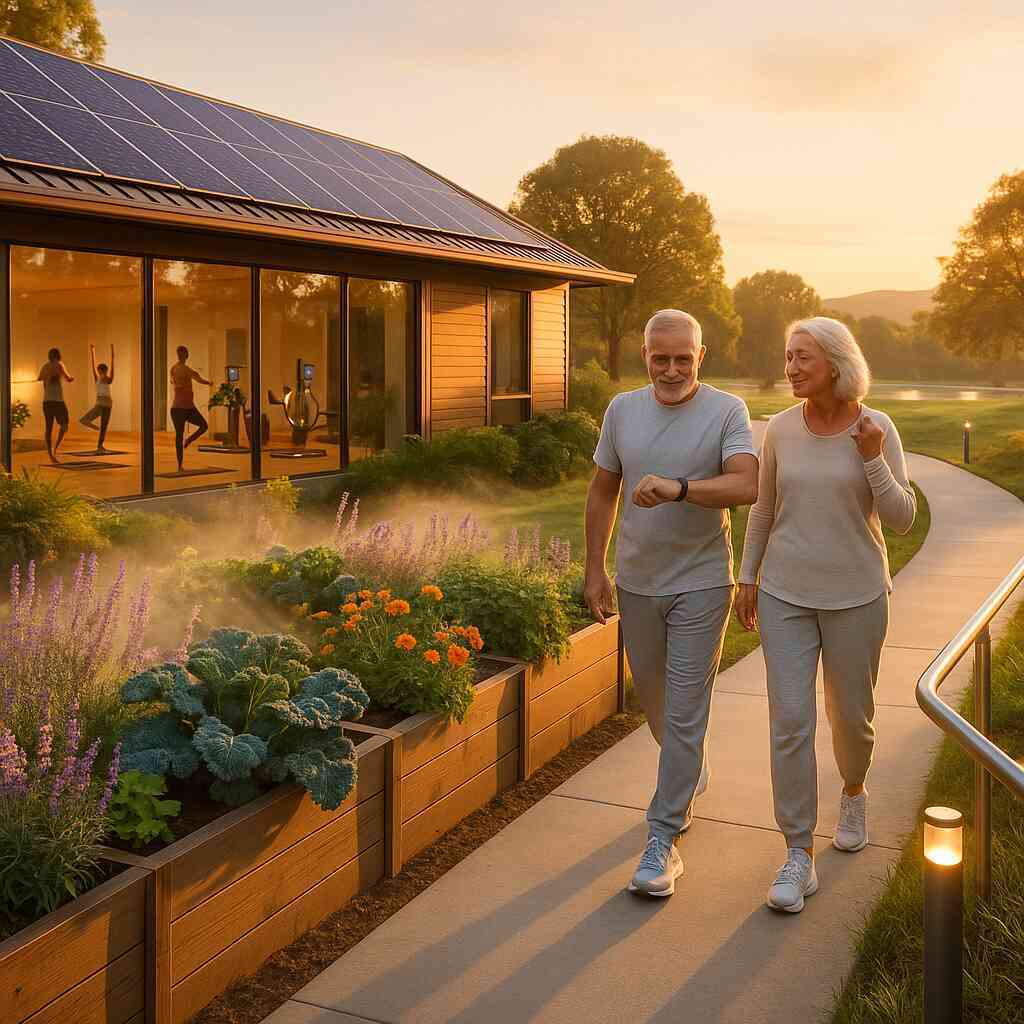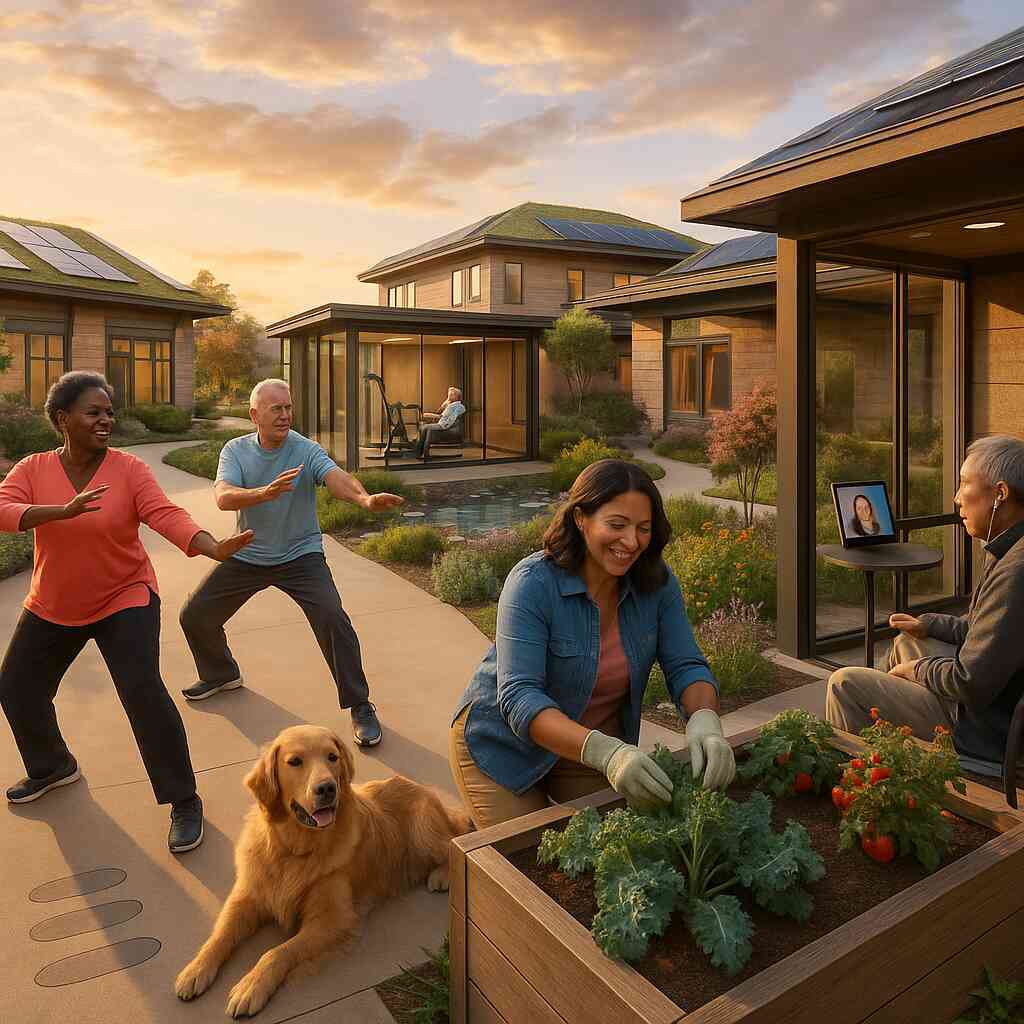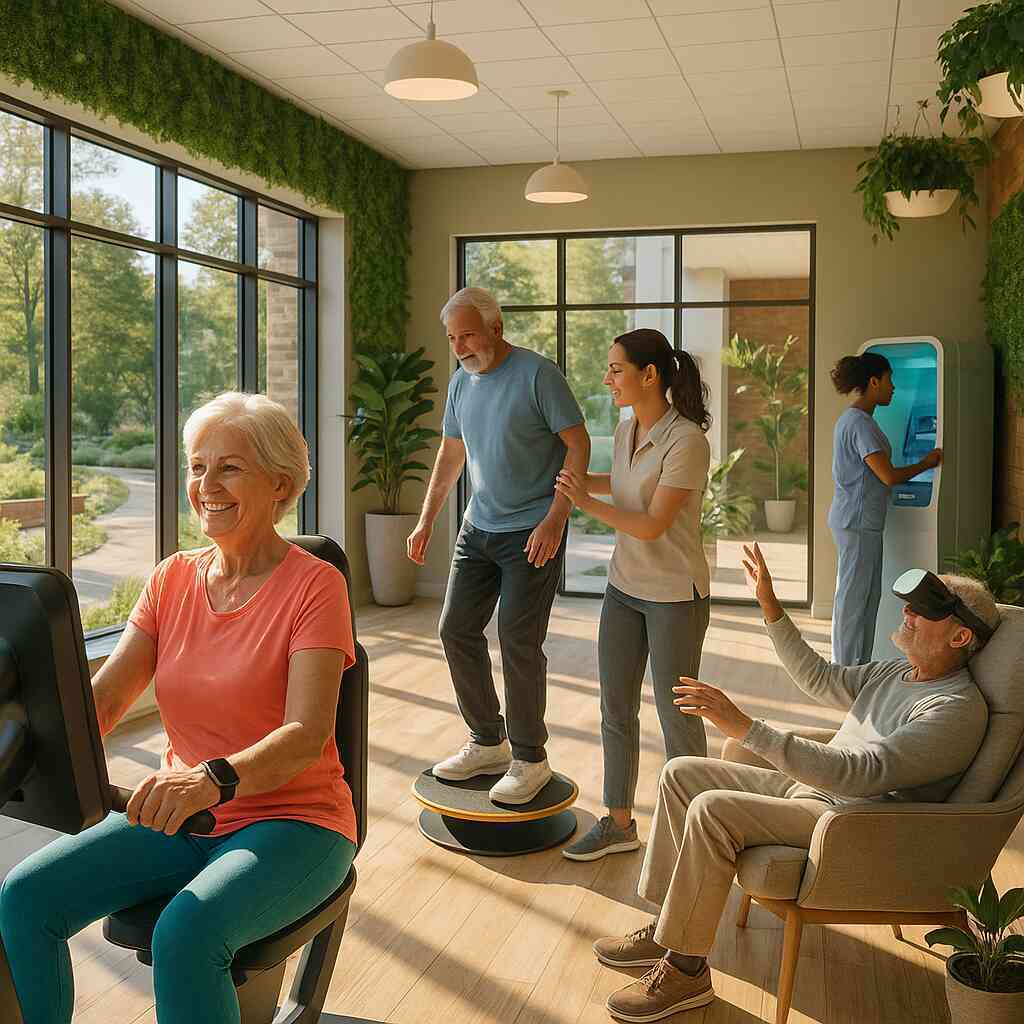
How Senior Living Facilities Adapt for Modern Wellness
October 22, 2025
Welcoming the Age of Modern Holistic Health for Seniors
From custodial care to purpose driven living
The old model emphasized custodial care-keep residents clean, fed, and protected. Today, communities for seniors 55+ emphasize purpose, inviting residents to set personal intentions and shape daily rhythms. Staff members trained as wellness coaches collaborate with residents on assisted living plans that prioritize autonomy as well as safety. Whether someone moves into senior apartment rentals or transitions from nursing homes for the elderly, the goal remains identical: ignite passion. Purpose driven living has proven to strengthen immunity, improve mood, and reduce hospital visits.
Retirees accustomed to careers, travel, and volunteering refuse to surrender those identities. A seniors living community adapts by offering resident-run committees, peer-taught classes, and volunteer partnerships. Housing options for seniors include studios with craft-room access and rental housing for seniors near walking trails so residents can mentor local hikers. Such choices empower newcomers to keep contributing while receiving discreet support with activities of daily living. The result? Flourishing individuals who inspire peers and staff alike.
How a senior living community becomes a wellness ecosystem
Building a true wellness ecosystem starts with interdisciplinary teams. Dietitians, physical therapists, and mental-health clinicians meet weekly to align programs with resident metrics. They adjust menus for anti-inflammatory benefits, fine-tune fall-prevention fitness, and schedule mindfulness circles in acoustically tuned rooms. This layered approach positions senior housing as a proactive shield against chronic disease.
Physical spaces evolve in tandem with programming. On-site greenhouses supply organic produce, while indoor walking tracks encourage year-round movement. Smart lighting syncs with circadian rhythms, improving sleep and cognition. An assisted living locator might highlight spa suites, therapy pools, and telehealth pods as standard amenities. By integrating technology, nature, and clinical expertise, the campus itself becomes a therapeutic agent.
Meeting the expectations of active older adults and their families
Adult children research “senior living near me” and expect transparency, quality, and flexibility. They compare fall-risk scores, chef credentials, and Wi-Fi speeds just as carefully as cost. Communities address these expectations by publishing outcome dashboards, hosting virtual tours, and offering contract options ranging from independent cottages to memory support studios. Families appreciate the seamless continuum.
Modern marketing promises must align with lived experience. Active adults want senior living near you that includes Pilates reformers, eco-certified cleaning practices, and plant-forward dining. They seek senior living in the state of their choice that still feels like home, not a hospital. Responsive providers therefore design pet-friendly courtyards, resident art galleries, and tech lounges for video calls. Meeting or surpassing these expectations fosters trust, boosts referrals, and solidifies the facility’s reputation as a benchmark of holistic health.
Designing Senior Living Facilities’ Wellness Programs That Inspire
Personalized nutrition plans and sustainable dining options
Senior living facilities’ wellness programs begin with the plate, because food is the first medicine residents experience daily. Registered dietitians analyze lab results, medication interactions, and cultural preferences before writing personalized nutrition plans for elders. Many communities harness innovative senior living wellness platforms to coordinate recipes, monitor nutrient intake, and report outcomes. As a result, chefs can pivot from sodium-aware menus to anti-inflammatory dishes without delay, fueling vibrant energy rather than empty calories. Transparent dashboards also help families view progress, reinforcing trust while supporting the community’s commitment to modern holistic health for seniors.
Sustainability now frames every dining discussion. Culinary teams source produce from on-site gardens, local farms, and certified sustainable fisheries whenever feasible. They reduce single-use plastics, compost kitchen scraps, and track carbon footprints for continuous improvement. Residents taste the difference in seasonal soups, plant-forward entrées, and flavorful herbs grown mere steps away. Such sustainable dining options in senior communities prove that environmental stewardship can coexist with delicious, therapeutic cuisine.
Adaptive exercise equipment and fall prevention fitness routines
Movement keeps bones strong, cognition sharp, and spirits lifted. Therefore, senior apartment rentals with on-site gyms equip adaptive exercise equipment for seniors that adjusts resistance, grip width, and seat height with one swipe. Technology-guided strength machines record repetitions and celebrate milestones, making progress tangible for every ability level. Trained wellness coaches craft fall prevention fitness routines that integrate balance boards, low-impact cardio, and tai chi flows, lowering incident rates dramatically. Metrics then inform updated assisted living plans, maintaining momentum while protecting mobility.
Designers place these gyms near walking paths and therapy pools, encouraging cross-training throughout the week. Bright floor markings suggest safe stride lengths, while mirrored walls provide instant posture feedback. Audible countdown cues assist residents with visual limitations, whereas vibration pads alert those with hearing loss. Collectively, these features transform risk reduction into an engaging, confidence-building adventure. Seniors depart sessions exhilarated, not exhausted, and eagerly invite friends to join next time.
Mindfulness classes and mental health support circles
Holistic health extends beyond muscles and joints; emotional resilience matters equally. Communities for seniors 55+ schedule daily mindfulness classes in senior communities to cultivate calm, enhance focus, and reduce anxiety. Facilitators teach breathing exercises, gentle chair yoga, and guided imagery inside acoustically treated studios. Soft lighting mimics sunrise, priming circadian rhythms for restorative sleep later. Participants often report improved mood, fewer headaches, and deeper social connections after only a few weeks.
Mental health support in senior living integrates group therapy, confidential counseling, and peer-led discussion circles. Licensed clinicians collaborate with activity directors to normalize conversations around grief, transition, and purpose. Sessions might explore storytelling, gratitude journals, or solution-focused problem solving, always respecting individual comfort levels. By embedding support within regular programming, administrators eliminate stigma and create a true safety net. The campus becomes a sanctuary where every feeling is acknowledged and addressed.
Cognitive stimulation activities and brain health workshops
Neuroplasticity does not retire. Instead, it responds enthusiastically to challenge, novelty, and meaningful interaction. Therefore, cognitive stimulation activities for memory care include bilingual word games, digital piano lessons, and strategy-based board tournaments. Residents track progress on colorful charts that reward consistency rather than perfection, reinforcing intrinsic motivation. Staff rotate activities monthly, ensuring fresh puzzles reach every neighborhood within the senior housing campus.
Brain health workshops in senior housing invite neurologists, occupational therapists, and local university researchers to translate complex science into practical habits. Lectures cover sleep hygiene, hydration, and hearing protection-all shown to preserve cognitive reserves. Attendees then practice new skills through interactive stations measuring reaction speed and pattern recognition. This hands-on format turns abstract neuroscience into actionable daily routines, supporting sustained mental agility.
Art music and pet therapy are weaving joy into daily schedules
Color and rhythm unlock memories, spark laughter, and foster community. Art and music therapy in assisted living locations therefore occupy prime calendar slots. Watercolor studios feature ergonomic easels and non-toxic pigments, ensuring accessibility for tremor-prone hands. Meanwhile, drumming circles blend motor coordination with collective celebration, allowing even non-verbal residents to contribute powerful beats. Every session yields not just artwork but also boosted serotonin and a renewed sense of identity.
Pet therapy in nursing homes introduces certified dogs, miniature horses, and even gentle rabbits to the long-term care facility hallways. Stroke survivors practice hand extension by brushing fur, while those with dementia recall beloved childhood pets. Heart rates drop, smiles widen, and communal stories bloom around each animal visit. These multisensory moments weave joy into routines, elevating the mood community-wide.
Outdoor therapy gardens and green spaces in senior housing design
Biophilic design turns landscapes into partners in healing. Outdoor therapy gardens feature raised beds, smooth pathways, and contrasting plant colors to aid depth perception. Residents tend herbs, sample strawberries, and track monarch butterflies, gaining gentle exercise plus vitamin D. Green spaces in senior housing design also include shaded meditation nooks and accessible water features, inviting reflection at any hour.
Research links regular nature exposure with lower blood pressure and enhanced executive function. Therefore, architects position apartments so every resident views foliage, even during inclement weather. Covered verandas host stretching classes when rain falls, ensuring continuity of wellness programs. The environment itself becomes a therapeutic agent, complementing clinical care with soothing sensory input.
Resident led wellness committees cultivating social engagement initiatives
Purpose fuels participation, and nothing instills purpose like ownership. Resident-led wellness committees meet monthly to evaluate programming, propose innovations, and allocate micro-grants for pilot projects. Suggestions range from dance flash mobs to community herb drying workshops. Staff listen, facilitate logistics, and track follow-through while respecting resident autonomy. Consequently, social engagement initiatives in retirement homes stay relevant, dynamic, and resident centric.
Committees also mentor newcomers, reducing isolation during transition. Experienced members invite new neighbors to join planning sessions, share facility maps, and explain activity sign-ups. This peer support doubles as leadership training and friendship formation. Over time, a culture of co-creation supersedes traditional top-down scheduling, further distinguishing the community’s wellness identity.
Integrative medicine and chronic disease management in long term care facility settings
Chronic disease management in long-term care facility settings now embraces integrative medicine, merging conventional treatments with evidence-based complementary therapies. Physicians collaborate with acupuncturists, massage therapists, and herbal pharmacists to create comprehensive care pathways. Residents receive individualized sessions that address pain, inflammation, and sleep disturbances without over-reliance on pharmaceuticals. Progress is monitored through wearable data and regular lab work, ensuring safety and efficacy remain paramount.
Integrative teams hold monthly case conferences, reviewing outcomes against national benchmarks and resident satisfaction surveys. When metrics show improvement, best practices roll into facility-wide protocols, raising the standard of care. Families appreciate this proactive stance, viewing the community as an ally in the prevention-oriented journey toward longevity and quality of life.
 Tech Powered Communities for Seniors 55 plus with Wellness Centers
Tech Powered Communities for Seniors 55 plus with Wellness Centers
Smart home technology in assisted living and aging in place solutions
First, communities for seniors 55+ install sensor-rich apartments that learn habits and flag anomalies before they become crises. Motion trackers, automated lighting, and voice assistants together define smart home technology in assisted living, turning every residence into a protective cocoon. Industry analysts document the pivotal impact of technology on contemporary senior living as families demand data-verified safety. Residents simply live their routines while hidden systems adjust temperature, unlock doors for caregivers, and alert nurses when patterns deviate. Peace of mind rises, and staffing shortages ease because machines shoulder midnight rounds.
Furthermore, aging in place technology solutions now integrate medication drawers that open only at prescribed times and refrigerators that nudge hydration. These supportive prompts dovetail with individualized assisted living plans, promoting independence without sacrificing oversight. Rental housing for seniors gains market appeal when accompanied by such adaptive infrastructure. As software updates remotely, capital costs stretch further and keep environments future-ready. Ultimately, autonomy flourishes because innovation removes fear, not freedom.
Telehealth services and remote vital sign monitoring for older adults
Telehealth services for older adults have shifted from novelty to necessity, linking residents with specialists nationwide within minutes. High-definition kiosks reside in wellness centers, while tablets allow private bedside consultations, avoiding stressful transport. Clinicians adjust medications swiftly once remote vital sign monitoring flags blood-pressure spikes, preventing emergency visits. This seamless pipeline turns long-term care facilities into virtual outpatient hubs, saving families travel time and costs. As reimbursement models evolve, administrators celebrate both clinical and financial dividends.
Equally important, cloud dashboards compile heart rate, oxygen saturation, and blood glucose readings into color-coded trends. Wellness coaches then translate numbers into actionable lifestyle tweaks, reinforcing preventive care in senior communities in Arizona and beyond. Family members receive opt-in alerts that foster collaboration rather than surprise. Because every stakeholder shares the same real-time picture, trust deepens across generations. Tele-enabled transparency therefore becomes a cornerstone of modern holistic health for seniors.
Virtual reality therapy and immersive memory care experiences
Virtual reality therapy now transports wheelchair users to mountain trails and painters to Parisian galleries without leaving the lounge. Headsets calibrated for bifocals deliver 360-degree vistas, sparking joy while stimulating neural pathways. Memory-care residents revisit childhood neighborhoods, unlocking autobiographical recall that traditional photos rarely evoke. Therapists witness calmer moods and reduced sundowning after each immersive session. Consequently, virtual journeys supplement medications with experiential wonder.
In addition, collaborative VR platforms allow residents to fish together or co-author digital murals, nurturing social bonds across cognitive levels. Staff can customize programs by uploading family videos or local landmarks, reinforcing personal relevance. These immersive memory care experiences complement art and music therapy in assisted living locations, creating multisensory rehabilitation. Because sessions log engagement metrics, clinicians refine protocols for maximum benefit. Technology thus transforms nostalgia into a measurable therapeutic tool.
Wearables data fueling preventive assisted living plans
Smartwatches and adhesive biosensors continually stream gait speed, sleep cycles, and hydration data to secure clouds. Algorithms highlight deviations that precede falls, enabling staff to adjust fall prevention fitness routines before incidents occur. Wearables therefore convert raw numbers into early warnings that keep residents mobile longer. Families appreciate the proactive stance, seeing value beyond traditional call-button systems. The result is a culture where prevention outranks reaction.
Moreover, multidisciplinary teams integrate these insights into dynamic assisted living plans emphasizing preventive care. Dietitians might boost magnesium after detecting restless nights, while physical therapists tweak balance drills following subtle stride changes. Because information arrives daily, interventions remain timely and personalized. Residents feel seen rather than sampled, motivating continued compliance with wellness programs. Data literacy thus elevates every stakeholder, from caregiver to consumer.
Interactive platforms for wellness coaching and social connection
Robust Wi-Fi enables interactive platforms where residents schedule classes, message coaches, and track milestones through intuitive dashboards. Gamified challenges encourage friendly competition, rewarding steps walked or mindfulness minutes logged. Virtual badges unlock real-world perks like smoothie vouchers, reinforcing healthy habits. Coaches review progress and send motivational videos, sustaining engagement between in-person sessions. This always-on guidance transforms isolated workouts into community quests.
At the same time, platforms act as digital piazzas, hosting book clubs, caregiver Q&A forums, and intergenerational language exchanges. Seniors invite grandchildren into shared spaces, bridging miles through collaborative puzzles and karaoke. Social engagement initiatives in retirement homes therefore gain new traction when pixels supplement proximity. Because loneliness scores drop, depressive symptoms follow suit, validating technology’s emotional dividends. Connection, not just convenience, defines the modern wellness network.
Eco friendly senior living facility features supported by smart grids
Finally, eco-friendly senior living facilities feature mesh with smart grids to lighten environmental footprints while cutting utility costs. Solar arrays feed community microgrids, and intelligent thermostats modulate HVAC demand based on occupancy sensors. Residents monitor collective savings on lobby dashboards, linking personal conservation to communal success. Such visibility cultivates stewardship alongside comfort, proving sustainability can feel luxurious.
In Colorado, engineers pair rainwater harvesting with greywater recycling to irrigate therapy gardens, showcasing what eco-friendly senior living facilities in Colorado already achieve. Electric vehicle charging stations draw power during off-peak hours, while battery storage guarantees uninterrupted oxygen concentrators during grid disturbances. These green innovations dovetail with wellness priorities, delivering cleaner air and quieter spaces for meditation. Technology, therefore, safeguards both planetary and personal health within tomorrow’s senior housing.
A Future Proof Path for Senior Living Near You
Intergenerational programs linking residents with local schools and volunteers
Senior living facilities thrive when generations mingle. Administrators partner with nearby schools to create mentorship circles where residents tutor reading, math, and art. These weekly sessions boost student confidence while stimulating elder cognition, satisfying both social engagement initiatives in retirement homes and educational goals. Volunteers also join gardening clubs and coding workshops, introducing fresh ideas that keep campuses vibrant. Because purpose blossoms through shared discovery, residents report elevated mood and sharper memory after every visit.
Community planners design flexible spaces to support these intergenerational experiences. Movable walls transform lounges into science labs, while outdoor therapy gardens double as biology classrooms. Safe walking paths allow children and elders to explore nature side by side, promoting healthy movement across ages. Staff coordinate transportation, background checks, and activity supplies, removing logistical barriers that might deter participation. Consequently, seniors feel valued, young people gain wisdom, and the wider neighborhood sees the facility as a cultural hub.
Metrics that matter tracking outcomes of senior living facilities’ wellness programs
Data-driven care turns inspiration into measurable progress. Wellness teams set clear benchmarks for fall rates, blood pressure averages, and social satisfaction scores. Digital dashboards update in real time, giving residents and families transparent proof of improvement. When metrics plateau, interdisciplinary committees adjust assisted living plans, ensuring continued momentum. This feedback loop reflects modern holistic health for seniors because it balances empathy with evidence.
Facilities also publish anonymized quarterly reports to stakeholders. These documents compare results against regional and national standards, showcasing leadership in preventive care in senior communities in Arizona and beyond. Infographics explain complex figures in friendly language, reinforcing trust. Meanwhile, success stories highlight individual triumphs, reminding readers that behind every statistic lives a unique person. By celebrating numbers and narratives together, communities sustain support for ongoing innovation.
Creating rental housing for seniors near walking trails and on site gyms
Location still shapes lifestyle. Developers now prioritize rental housing for seniors near walking trails, lakes, and pocket parks, making daily exercise effortless. Indoor corridors connect seamlessly to paved loops, protecting residents from weather extremes. On-site gyms feature adaptive exercise equipment for seniors, while wall-length windows offer calming views of greenery. The design encourages spontaneous activity, turning wellness from an appointment into a habit.
Affordability remains central. Tiered pricing models let older adults select studio, one-bedroom, or cottage layouts without sacrificing access to amenities. Monthly fees cover group classes, fall prevention fitness routines, and maintenance of shared landscapes. Because movement opportunities surround every address, residents need fewer costly medical interventions. Families see tangible value, and waiting lists grow long before ribbon cutting.
Using the Senior Living Facilities platform to locate senior living near me focused on modern wellness
Families seeking cutting-edge support often start online. The Senior Living Facilities website simplifies the journey with intuitive filters for care level, budget, and amenity priorities. Users quickly compare smart home technology in assisted living, telehealth services for older adults, or eco-friendly design elements. A robust knowledge base clarifies terminology, while live advisors answer nuanced questions about activities of daily living support and insurance compatibility.
When ready, visitors tap a single button to locate senior living communities focused on wellbeing. The platform then displays curated options across all states, including technology-forward assisted living in Texas and active lifestyle retirement options in New York. Side-by-side charts reveal wellness metrics, resident testimonials, and virtual tour links, enabling confident decisions from the comfort of home. Because the database updates continuously, families avoid outdated listings and secure placements aligned with evolving wellness standards.
 Frequently Asked Questions
Frequently Asked Questions
Question: How do Senior Living Facilities ensure I find senior living near me that offers truly personalized nutrition plans for elders?
Answer: Our search and comparison engine lets you filter communities by dietitian services, farm-to-table dining, and medical nutrition therapy. Once you enter your zip code, we display only senior living facilities that publish sample menus, lab-driven meal adjustments, and dashboards tracking nutrient intake. Because we stay in close contact with culinary teams, you can review sodium-aware or anti-inflammatory menu cycles before you even schedule a tour. This transparency helps families confirm that personalized nutrition plans for elders are more than marketing language-they’re documented, data-backed practices.
Question: What smart home technology in assisted living communities for seniors 55+ do your partner facilities provide to promote safe aging in place?
Answer: The majority of properties in our database now integrate motion sensors, voice-activated lighting, automated medication drawers, and remote vital-sign monitoring as standard amenities. During the Compare step, you’ll see icons that flag apartments equipped with these aging in place technology solutions. We also highlight whether communities layer in telehealth services for older adults, so residents can consult physicians without stressful travel. Because Senior Living Facilities verifies tech specs during every quarterly update, families can trust that listed features-such as keyless entry or stove-shutoff alerts-are live, not coming soon.
Question: The blog How Senior Living Facilities Adapt for Modern Wellness mentions daily mindfulness classes in senior communities. How do you match residents with campuses offering robust mental health support?
Answer: When you begin a search, our intake form asks about priorities like meditation studios, mental health counseling, and peer-led support circles. Our algorithm then scores each senior’s living community on the depth of its mindfulness classes, availability of licensed clinicians, and resident satisfaction ratings in emotional wellness. Advisors can share weekly calendars, photos of acoustic yoga rooms, and outcome data-such as reduced anxiety scores-to prove each campus’s commitment. This level of detail ensures your loved one lands in a setting where modern holistic health for seniors includes both body and mind.
Question: Can Senior Living Facilities help me compare fall prevention fitness routines and adaptive exercise equipment for seniors across different senior apartment rentals with on-site gyms?
Answer: Absolutely. Our comparison grids list whether a community offers balance boards, vibration platforms, or technology-guided resistance machines that automatically adjust to each user. We also display incident-rate reductions tied to fall prevention fitness routines, so you’re not just seeing equipment lists-you’re seeing results. If two senior apartment rentals appear similar, a personal advisor can pull staff certifications, resident testimonials, and wearable-data outcomes to pinpoint which on-site gym best supports your mobility goals.
Question: How do Senior Living Facilities verify eco-friendly senior living facility features like green spaces in senior housing design and sustainable dining options in the communities you list?
Answer: We require every long-term care facility or independent living community to submit documentation of LEED certifications, solar utilization, and waste-reduction metrics before tagging them as eco-friendly. Site visits and resident surveys confirm that therapy gardens, composting programs, and plant-forward menus are active, not aspirational. Because our platform serves all 50 states, you can filter for green spaces in senior housing design-whether you’re searching senior living near you in Florida or senior living in the state of Oregon-and trust that sustainability claims meet measurable standards.
 Tech Powered Communities for Seniors 55 plus with Wellness Centers
Tech Powered Communities for Seniors 55 plus with Wellness Centers Frequently Asked Questions
Frequently Asked Questions

